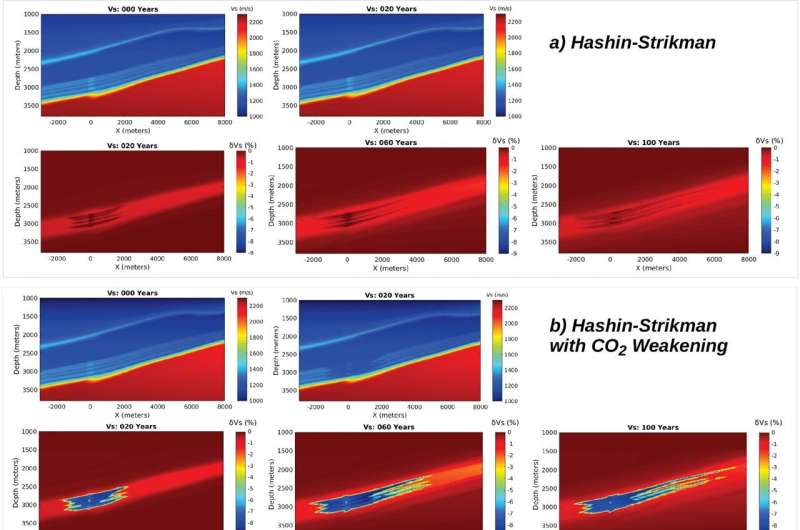This article has been reviewed according to Science X's editorial process and policies. Editors have highlighted the following attributes while ensuring the content's credibility:
fact-checked
peer-reviewed publication
trusted source
proofread
Rock physics model enhances seismic monitoring for carbon storage

Research from Los Alamos National Laboratory shows that a new rock physics model will provide more comprehensive and actionable data about how carbon dioxide changes rock properties throughout geologic storage sites, which will make monitoring for geologic carbon storage more reliable. The results were published in Communications Earth & Environment journal.
After CO2 is created, it is brought below ground into a permanent geologic storage site. This is intended to hold the CO2 without any leaks. The new rock physics model will help improve this system and reduce the amount of CO2 that is able to escape into the atmosphere.
"Using the new CO2 rock physics model will enable us to more accurately model the effects of CO2 in a storage reservoir not only on the compressional-wave velocity change, but also on the shear-wave velocity change," said Lianjie Huang, a senior research scientist at Los Alamos and co-author on the paper.
Geologic carbon storage is an integral part of reducing greenhouse gas emissions. However, current seismic monitoring methods of sequestered carbon dioxide underground is ineffective and does not properly account for several characteristics of the carbon dioxide-rocks interactions. The Los Alamos team proposed a new method to more thoroughly account for the interactions of CO2 with the reservoir rock.
Two competing models
The current accepted practice to account for CO2 underground is a model based on the Biot-Gassmann equation. This method is able to describe the elasticity of a rock when it is saturated by a fluid (in this case CO2).
"Biot-Gassmann's equation is used quite commonly (especially for geologic carbon storage)," explained first author Neala Creasy. "Based on experimental work, this approach doesn't consider nonlinear stress dependence and chemical reactions that weaken the rock frame."
Long-term exposure to CO2 can influence the elasticity of shear and bulk moduli within the CO2 -saturated rock, which causes the CO2 to act in ways that the Biot-Gassmann equation cannot fully describe, leading to inaccurate rock physics modeling.
The new rock physics model shows larger changes in elastic properties, particularly in the shear-wave velocity, compared with those modeled with the Biot-Gassmann equation. These results are consistent with laboratory experiments. This research increases in reliability for CO2 accounting using seismic monitoring.
Reliable monitoring for geologic carbon storage
Since these rock physics models govern geologic carbon storage, an improved system will allow scientists to better understand how CO2 moves throughout an underground reservoir. This in turn allows scientists to understand when and where there is a leak. Carbon capture and storage is an important tool for reducing emissions of greenhouse gases, but a leak in storage systems might pose significant risks to the environment and human beings.
Improving the rock physics models therefore lets scientists account for storage of CO2 and find and address leaks so that carbon storage is effective and environmentally safe.
"This new CO2 rock physics model is crucial for reliable seismic monitoring and CO2 quantification for geologic carbon storage," Huang said.
More information: Neala Creasy et al, CO2 rock physics modeling for reliable monitoring of geologic carbon storage, Communications Earth & Environment (2024). DOI: 10.1038/s43247-024-01493-6
Journal information: Communications Earth & Environment
Provided by Los Alamos National Laboratory





















